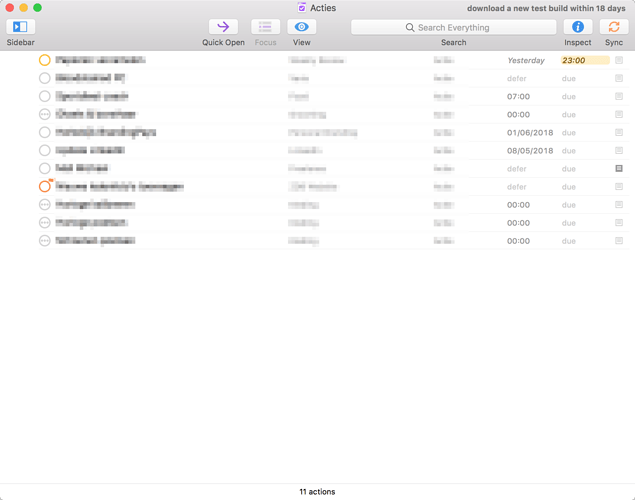I have played around with OmniFocus since the early Kinkless GTD days and some time after that I started using OmniFocus as my main productivity system. I have used and tested other applications extensively (Things 1-3, 2Do, The Hit List, TickTick, Todoist, and others). But none of them have really made me switch from OmniFocus.
The early days for me were filled with a lot of experimentation: just trying what works and what doesn’t. I imagine everyone knows the feeling of developing a proper workflow. And that’s already a big difference between Things and OmniFocus. Things tells you: this is the way you’ll manage your stuff. There’s Today, Upcoming, Anytime, Someday.
OmniFocus, however, let’s you decide how you’ll organize your system. That’s both a blessing and a curse, especially for newcomers. Since you start out with a blank canvas, you need to design what works best for you. But once you do: OmniFocus adapts to you and not the other way around. So you’ll probably be tinkering with OmniFocus for a bit, but once it clicks you’ve got your own productivity engine, tuned just the way you like it.
What’s more, as @heyscottyj pointed out, if you have a fair number of tasks, some applications simply cannot keep up. You may say: I keep things simple, I don’t have a lot of tasks. Sure, today. But what about tomorrow? Will your system scale? And have you really, genuinely captured everything inside your system? There may be more tasks than you realize. OmniFocus handles large databases easily. I found that, for example, Things really cannot keep up as the number of tasks increases. The same goes for projects, of course.
A third advantage of OmniFocus, again highlighted by @heyscottyj, is OmniFocus’s ability to only show you tasks that are relevant right now. To me, it’s one of the absolute key features of OmniFocus that other applications cannot emulate. First off, deferring tasks keeps them from your view simply because you cannot act on right now. There is no reason why I should be looking at a task I cannot start right now. The moment I can, it should show up.
Sequential tasks, too, are brilliant at hiding this you cannot work on and reducing complexity. To my knowledge, no other application does this as well as OmniFocus. For example, say you have a project laid out to design a website. And the next step is receiving input from a client. This input allows you to really start the rest of your tasks. Now in OmniFocus, the rest of your tasks are neatly hidden since you cannot work on them without any input from your client. There’s no need to show them. An application such as Things shows you that whole list at once, cluttering up your views with tasks that are totally irrelevant right now.
If you properly set up your system with the correct views and if you’re comfortable in building your workflow, Perspectives really are amazing. Perspectives show you exactly what you need when you need it. You may have a Work perspective that shows you everything you can do at work right now. And then you might have a Perspective that shows you what you can do next to finish a project at home.
Then there’s review. Reviewing your tasks in OmniFocus is so powerful that once you use it, you wonder why no other application has it. Now, you could sort of emulate this in other software, but it’s not the same as a proper review. OmniFocus allows you to set review intervals for each project. Some things I review weekly, others monthly. And working your way through a review one project at a time forces you to make decisions and adjust things. Reviewing is like servicing your engine: you’re making sure it runs smoothly at all times.
There’s lots more of course. Such as much more structure than other applications thanks to folders, action groups, and basically unlimited hierarchies. Or Location reminders. Now with tags and custom notifications, I have no doubt people will come up with even more amazing stuff. And have I mentioned how friendly and helpful the people at Omni are?
One final thing I want to highlight is the UI. OmniFocus regularly gets slammed for not being “as pretty” or “as minimal” as things. Things may be nice to look at, but don’t be fooled. I’ve set up OmniFocus to be very minimal. Looking at my list below, it shows me everything I need: one task is due today (23:00), the first task at the top of the list, and one flagged task I really need to work on (flagged, but no deadline). Everything else is neatly sorted by priority according to my main folders and projects outline. OmniFocus really is as complex or as simple as you make it out to be.
But let me summarize.
- OmniFocus has a learning curve, but it’s worth it in the longer run. Its flexibility ensures you are in charge of creating a system that works for you.
- Being able to hide what you can’t work on and show what you can (and should!) work on, keeps you very focussed. It keeps you from being overwhelmed.
- Reviewing ensures nothing falls through the cracks and ensures everything is up to date.
At the end of the day, for me, OmniFocus provides incredible peace of mind. It has been rock-solid and dependable all these years. I’ve never missed an important task and I’m always current with what I have to do. It’s a trusted system.
If you’re looking for a quick fix todo app, OmniFocus is not your best option. If you’re really serious about a system and if you’re taking a long view, OmniFocus is an incredible productivity system that I recommend very highly.

